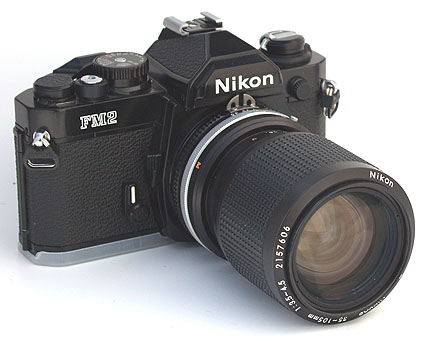I remember my son Petteri once mentioned: "If I had money, I would by a Nikon FM". He was enthusiastic about the fine mechanics and the manual operation of this wonderful camera. At the moment he was actually carrying a Nikon 801s. Today (2007) that Nikon is in my collection and he shoots with D200.
Nikon FM story begun in 1977 and several changes were made to that camera during the model lifetime which btw. is one of the longest in SLR history.
It is said: "If it works, don´t change it". In this case reforms were fairly moderate.
Primary differences on the newer models is in the highest shutter speed which went from 1/1000sec to 1/4000sec and a flash
synchronization speed, from 1/125 to 1/250sec.
The "first" FM2 was introduced in 1982 with a 1/4000 second carbon-fibre-reinforced titanium shutter. In the following year 1983 the sync. was changed to 1/250 (before it was 1 / 200 sec.) and the camera was named the FM2n. In 1989 the titanium shutter was dropped in favour of aluminum, which is less exotic but more reliable in extreme temperatures.
My camera is an example of the later Nikon FM2n model. (introduced in 1989) In front of the serial number is the only place where one finds the N suffix. So, there is at least two variations of "plain" FM2n. (T.Y.Bob) 
A most significant strength for Nikon SLR cameras is the Nikon F mount that has remained virtually unchanged since its introduction in 1959?
These FM models work with all Nikkor lens models past (Except the OP Fisheyes and Ultra wide Fisheyes Nikkor), present and even the latest AF-D lenses. Manual mode is naturally the only usable and specially when using the zoom lenses you may feel some inconvenience in handling. Still, what a mount and what a camera !
The production of FM2 was discontinued in 2002, making it, at two decades, one of the longest continuously-manufactured SLR's in the world.
The main versions in the nikon FM/FM2 history
- FM (1977) . This was the model that started this line of Nikon manual bodies. FM had a 1 - 1/1000sec horizontal titanium shutter.
- FM2 (1982) . The "original" FM2. The titanium shutter was completely reworked for this new model, providing 1 to 1/4000sec and 1/200 flash sync.
- FM2n (1983) . The flash sync speed was increased to 1/250 and the n suffix in front of the serial number.
- FM2n (1989) . The shutter was redesigned again,now made of aluminum alloy. No other changes were made.
- FM2n/T (1993) . The top and bottom plate of this version are made of titanium in other respect it is the same camera as FM2n.
Nikon FM2n is famous about its smooth and easy film winding mechanism and let me say that is not the only feature where you can feel the quality. The FM2n is a professional camera with a basic set of features and a great shutter. Shutter speeds are controlled in full stop increments from 1 second to 1/4000 and B. An MD-11 or MD-12 motor drive can be attached, which can drive the FM2n at up to 3.5 frames per second. |
 |
Specifications
Type: 35mm manual SLR , Nikon FM2 is available in chrome and black finish
Viewfinder: Eye-level pentaprism type, with 93% frame coverage and 0.86X viewfinder magnification with 50mm set at infinity
Viewfinder display: Shutter speed selected, f/number in use via ADR window, and 3 LEDs in 5 exposure graduation display for overexposure ( + ), correct exposure ( O ) & underexposure ( - )
Focusing screen: Split-image microprism type (Type K2) provided as standard; matte type (B) and matte with horizontal and vertical line etchings (E) optionally available.
Mirror: Automatic Instant Quick-return type
Film advance: Lever provided wind only in single stroke; 30° standoff angle and 135° winding angle. Automatic film advance is possible with optional Motor Drive MD-12.
Multiple exposure lever: Provided, disengages frame counter for correct count
Frame counter: Additive type (S, 0-36); Automatically resets when camera back is opened.
Film rewind: By crank provided after film rewind button is pressed
Exposure meter: TTL center-weighted full aperture exposure measuring system using a pair of SPD's (silicon photo diodes) from EV 1 to EV 18 at ASA/ISO 100 and with 50mm f/1.4 lens (i.e., from 1 sec. at f/1.4 to 1/4000 sec. at f/8.0)
Flash synchronization: Built-in hot shoe for mounting flash unit; sync cord terminal also provided; 1/250 sec. sync, LED blinks to warn of improper shutter speed setting. LED also lights when flash is recycled
Ready light: via second flash contact on accessory shoe; Glows inside the viewfinder when a dedicated flash is recycled; Also warns Out-of-Sync shutter speeds
Film sensitivity range: ASA/ISO 12-6400
Power source: Choice of one 3V lithium battery, two 1.55V silver-oxide batteries, or two 1.5V alkaline-manganese batteries
Exposure meter switch: Light pressure on shutter release button switches meter on; meter stays on for approximate. 30 sec. after finger leaves button, then automatically switches off
Self-Timer: Set/cancel type provided; approximate. 8-14sec. shutter release delay
Shutter Release Button: Switches meter ON when depressed halfway, threaded in center to accept standard cable release.
Battery power check: LED exposure display inside viewfinder lights up when the exposure meter is switched on if there is sufficient power left.
Dimensions: (W x H x D): 143mm x 90mm x 60mm
Weight : 540g.(FM2 bodies with titanium shutter 590g).

